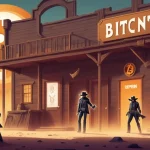XRP ETF Approval Nears: Ripple CEO Predicts Institutional Surge by 2025

XRP ETF Approval Looms: Ripple CEO Bets Big on Institutional Future
Ripple Labs CEO Brad Garlinghouse has thrown down the gauntlet, declaring an XRP Spot ETF not just likely, but inevitable, with a US SEC decision expected by October 2025. This bold prediction, paired with sky-high forecasts from industry players like Canary Capital, signals a potential turning point for XRP—from a speculative altcoin to a serious institutional asset.
- Decision Deadline: US SEC to rule on XRP Spot ETF by October 2025.
- Ripple’s Stance: Garlinghouse sees approval as a done deal, pushing crypto toward institutional legitimacy.
- Massive Projections: Canary Capital predicts $5 billion in inflows within the first month of an XRP ETF launch.
Ripple’s ETF Ambition: A Bridge to Big Money
Let’s get straight to the point: the buzz around an XRP Spot ETF isn’t new, but it’s reaching fever pitch thanks to Ripple’s top brass. Brad Garlinghouse is banking on this financial instrument to transform XRP’s role in the market, as noted in his recent comments on its inevitable launch. For the uninitiated, an Exchange-Traded Fund (ETF) is a vehicle that tracks an asset’s price—here, XRP—allowing investors to gain exposure without holding the actual cryptocurrency. It’s essentially a gateway for traditional finance to dip into the crypto pool without getting their suits wet. Garlinghouse views this as a pivotal shift, moving XRP from the realm of retail hype, where Twitter pumps and dumps dominate, to a space where institutional players like hedge funds and pension managers start paying attention. Why does this matter? Institutional adoption often brings stability, broader use in real-world finance, and, frankly, a stamp of legitimacy that crypto desperately needs.
Garlinghouse isn’t pulling this confidence out of thin air. He points to the hard-won success of Bitcoin Spot ETFs, which, after years of SEC stonewalling, finally opened the door to billions in capital. If Bitcoin—the unruly pioneer of decentralization—could crack that barrier, XRP should stand a fighting chance. It’s a solid parallel, but not airtight, and we’ll get to the cracks soon enough.
Legal Clarity Sparks Market Optimism
One massive hurdle for XRP has been its messy legal tango with the US Securities and Exchange Commission (SEC). For nearly five years, the SEC argued that XRP functions like a security—think stocks or bonds, subject to tight regulations—while Ripple insisted it’s a currency built for fast, cheap cross-border payments. This dispute cast a shadow over XRP’s future, spooking investors and clouding any ETF prospects. But a major turning point came in August 2025, when both sides dropped their appeals, ending the saga with a $125 million penalty slapped on Ripple, as detailed in recent updates on the SEC-Ripple resolution. While not a total victory for either party, the resolution cleared a lingering fog of uncertainty. The market responded swiftly—XRP’s price surged 11% to around $3.31, reflecting a wave of optimism that the worst regulatory headwinds might finally be behind us.
This legal truce is a game-changer. Bloomberg analysts now peg the odds of an XRP ETF approval at a staggering 95% by October 2025. ETFStore president Nate Geraci has even speculated that heavyweights like BlackRock could jump in with something like an iShares XRP ETF, arguing it’d be sheer nonsense for major issuers to overlook altcoins beyond Bitcoin and Ethereum. That kind of institutional muscle could turbocharge XRP’s credibility overnight.
Canary Capital’s Bold Bet: XRP Over Ethereum?
Enter Steven McClurg, CEO of Canary Capital, who’s doubling down with predictions that have the crypto space buzzing. He’s forecasting a jaw-dropping $5 billion in capital inflows within the first month of an XRP ETF launch—a number that sounds like it belongs in a sci-fi novel, as explored in Canary Capital’s inflow analysis. His reasoning, though, has some bite. Unlike Ethereum, where investors might balk at missing out on staking rewards (a process where you lock up tokens to earn yields, akin to interest on a savings account), XRP doesn’t offer staking. This means an ETF becomes the simplest, cleanest way to invest without feeling like you’re leaving money on the table. McClurg also highlights XRP’s sharper focus—dominating the cross-border payments niche with less competition compared to Ethereum’s overcrowded smart contract arena. Add to that the fervent XRP Army, a community known for its die-hard loyalty, and you’ve got a recipe for explosive demand.
McClurg isn’t just hyping for hype’s sake—he’s positioning XRP ETFs to potentially outshine Ethereum ETFs already in play, a comparison further discussed in this XRP versus Ethereum ETF analysis. But let’s pump the brakes for a second. Canary Capital’s track record on such moonshot predictions isn’t widely documented, and $5 billion in a month feels more like a marketing hook than a locked-in outcome. Still, the logic behind XRP’s unique positioning holds water, at least on paper.
XRP’s Payments Niche: A Unique Selling Point
What sets XRP apart in this ETF race isn’t just community hype or legal wins—it’s Ripple’s laser focus on cross-border payments. Through RippleNet, a network partnering with banks and remittance firms, XRP facilitates near-instant, low-cost transactions across borders, solving a real-world pain point that Bitcoin (a store of value) and Ethereum (a smart contract hub) don’t directly tackle. This niche gives XRP a clearer identity for institutional investors who crave practical use cases over speculative buzz. Imagine a world where your overseas wire transfer doesn’t take days or cost an arm and a leg—that’s the promise Ripple’s pushing, and an ETF could amplify its visibility among finance bigwigs looking for the next disruptive tech. For more background on Ripple’s operations, check out this overview of Ripple Labs.
Compare this to Bitcoin, the gold standard of decentralized value, which remains king for those prioritizing censorship resistance and sovereignty over fiat. XRP doesn’t compete there, nor should it. Its strength lies in utility, carving out a lane that complements rather than challenges Bitcoin’s dominance. Ethereum, meanwhile, faces a dozen rivals in its space—Solana, Cardano, you name it—making XRP’s less contested territory a potential edge for ETF appeal.
Hype vs. Hard Reality: Regulatory Roadblocks Remain
Before we start popping champagne, let’s face the ugly truth: the SEC isn’t exactly crypto’s biggest fan. Despite the Ripple lawsuit wrapping up, the agency’s history with ETFs is a graveyard of delays and rejections. Early Bitcoin ETF applications were shot down for years over concerns like market manipulation and investor protection—issues that haven’t magically vanished for altcoins like XRP. Even with a 95% approval probability floating around, the SEC could still drag its feet past October 2025 or slap on conditions that water down the ETF’s impact. Broader altcoin regulation remains a patchwork mess, and XRP’s corporate backing via Ripple raises eyebrows among purists who question its decentralization. Unlike Bitcoin, where no single entity controls the supply, Ripple holds a hefty chunk of XRP tokens, sparking debates over whether it’s truly a decentralized asset or a dressed-up corporate coin. Could this spook regulators or investors? It’s a risk worth chewing on, with some community discussions like those on Quora exploring XRP ETF approval odds.
Then there’s the speculative froth around price impacts. Some corners of the internet are tossing out figures like $26 per XRP if McClurg’s $5 billion inflow hits, based on past buying trends amplifying market cap by hundreds of times. Others, like Google’s Gemini platform, keep it tame with a range of $3.99 to $4.41. Honestly, I wouldn’t bet a single satoshi on any of these numbers—crypto’s a volatile beast, and these predictions often reek of hype over hard data. The real takeaway isn’t a price tag; it’s the potential for a market cap surge that could lift XRP’s profile, provided the ETF even gets off the ground.
Community Risks and Centralization Critiques
The XRP Army’s passion is a double-edged sword. Their relentless support could drive ETF demand through the roof, mirroring how Bitcoin maximalists or Ethereum devs rally around their ecosystems. But if the ETF flops—or worse, gets rejected outright—that same fervor could turn to disillusionment. Retail investors, hyped on promises of mooning prices, might dump their holdings in frustration, tanking XRP’s value and denting Ripple’s credibility. It’s happened before in crypto; look at the fallout from failed altcoin promises in the 2017 ICO craze. Over-optimism is a silent killer, and the XRP community isn’t immune, as seen in various Reddit threads on XRP ETF predictions.
Zooming out, there’s a deeper critique we can’t dodge: Ripple’s control over much of XRP’s supply fuels accusations of centralization. Hardcore decentralization advocates—myself included on most days—raise an eyebrow at any project where a single entity holds such sway. This isn’t just philosophical nitpicking; it could sway institutional trust or give the SEC ammo to argue XRP doesn’t fit the “decentralized asset” mold they might prefer for ETFs. It’s a tension between effective accelerationism (pushing crypto into the mainstream fast) and preserving the ethos of autonomy that birthed Bitcoin. Can XRP thread that needle without losing its soul to regulatory compromise? I’m rooting for it, but I’m not blind to the trade-offs.
Industry Implications: A Test for Altcoin ETFs
The XRP ETF saga isn’t just about one coin; it’s a proving ground for altcoins writ large. If Ripple pulls this off, it could open the floodgates for others—Solana, Cardano, maybe even Polkadot—to pitch their own ETFs, diversifying the crypto investment landscape beyond Bitcoin and Ethereum. This aligns with the spirit of effective accelerationism: speeding up crypto’s integration into traditional finance to disrupt the status quo. But there’s a flip side. Each step toward Wall Street risks pulling crypto closer to the very systems we aim to dismantle—central banks, overregulation, and sanitized control. An XRP ETF might be a win for adoption, but at what cost to the raw, rebellious heart of decentralization? Playing devil’s advocate, I wonder if we’re trading long-term freedom for short-term gains.
Historically, Bitcoin’s ETF journey offers a roadmap. It faced relentless SEC pushback over market integrity fears before finally breaking through, proving persistence pays. XRP, with Ripple’s corporate muscle and legal battles behind it, has a different flavor of fight—but the parallels suggest approval isn’t a pipe dream. Still, unlike Bitcoin’s grassroots ethos, XRP’s centralized baggage adds a wrinkle that could make or break its case in the eleventh hour.
Looking Ahead: Disruption or Disappointment?
As October 2025 inches closer, the crypto world watches with bated breath. Will an XRP ETF mark the moment altcoins cement their place in mainstream finance, or will it be another overhyped letdown in a space littered with broken promises? The optimism from Garlinghouse and McClurg is infectious, and the legal clarity with the SEC adds serious weight. Yet regulatory ghosts and community expectations loom large, reminding us that nothing’s guaranteed in this game.
At its core, this isn’t just about XRP. It’s about testing whether decentralized tech can truly upend the financial old guard—or if those gatekeepers still call the shots. While I lean toward Bitcoin’s unassailable role as the ultimate decentralized store of value, I see XRP’s push as a necessary experiment in niche innovation. Win or lose, it’s a step toward a freer, more disruptive future. The clock’s ticking, SEC. Make your move.
Key Takeaways and Burning Questions
- What’s the likelihood of an XRP Spot ETF approval by October 2025?
Bloomberg analysts give it a 95% shot, bolstered by the recent Ripple-SEC legal resolution, though the SEC’s cautious history with crypto ETFs keeps a sliver of doubt alive. - How could an XRP ETF transform the crypto market?
It might fast-track institutional investment, funneling billions into XRP and elevating altcoins’ credibility, though it risks inflating retail hype to dangerous levels. - Why does Canary Capital bet on XRP ETFs over Ethereum ETFs?
Steven McClurg points to XRP’s lack of staking competition, focused payments niche, and rabid community support, projecting a $5 billion inflow in the first month—though that figure demands skepticism. - What obstacles could derail XRP ETF approval?
The SEC’s lingering doubts on market manipulation, altcoin regulation gaps, and XRP’s centralization concerns tied to Ripple’s control could delay or deny the ETF despite legal progress. - Are XRP price predictions post-ETF worth trusting?
Hard no—ranges from $4 to $26 are pure guesswork given crypto’s chaos; focus on fundamentals like adoption and market cap potential instead of chasing lottery-ticket forecasts. - What does an XRP ETF mean for altcoin regulation and adoption?
Success could pave the way for other altcoin ETFs, accelerating crypto’s mainstream push, but it might also invite tighter regulatory oversight, testing the balance between growth and decentralization.



